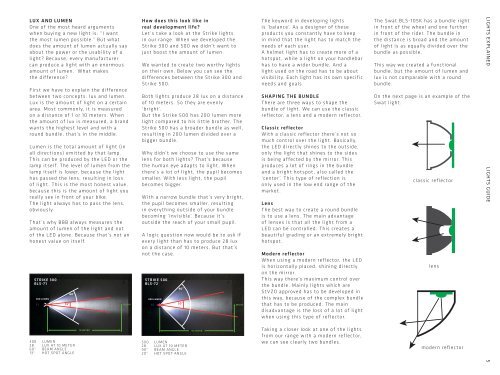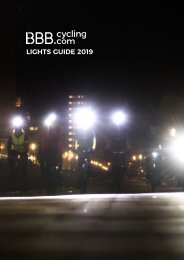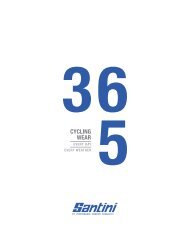BBB Cycling Australia - Light Guide 2018
Brighten your ride Riding in the dark is a challenge, and opens up a whole new level of possibilities. Don't let unreliable lights ruin your night ride. With BBB lighting solutions, you'll never have to rely on moonlight and luck again. BBB Cycling Australia - Light Guide 2018
Brighten your ride
Riding in the dark is a challenge, and opens up a whole new level of possibilities. Don't let unreliable lights ruin your night ride. With BBB lighting solutions, you'll never have to rely on moonlight and luck again.
BBB Cycling Australia - Light Guide 2018
Create successful ePaper yourself
Turn your PDF publications into a flip-book with our unique Google optimized e-Paper software.
LUX AND LUMEN<br />
One of the most heard arguments<br />
when buying a new light is: “I want<br />
the most lumen possible.” But what<br />
does the amount of lumen actually say<br />
about the power or the usability of a<br />
light? Because, every manufacturer<br />
can produce a light with an enormous<br />
amount of lumen. What makes<br />
the difference?<br />
First we have to explain the difference<br />
between two concepts: lux and lumen.<br />
Lux is the amount of light on a certain<br />
area. Most commonly, it is measured<br />
on a distance of 1 or 10 meters. When<br />
the amount of lux is measured, a brand<br />
wants the highest level and with a<br />
round bundle, that’s in the middle.<br />
Lumen is the total amount of light (in<br />
all directions) emitted by that lamp.<br />
This can be produced by the LED or the<br />
lamp itself. The level of lumen from the<br />
lamp itself is lower, because the light<br />
has passed the lens, resulting in loss<br />
of light. This is the most honest value,<br />
because this is the amount of light you<br />
really see in front of your bike.<br />
The light always has to pass the lens,<br />
obviously.<br />
That’s why <strong>BBB</strong> always measures the<br />
amount of lumen of the light and not<br />
of the LED alone. Because that’s not an<br />
honest value on itself.<br />
STRIKE 300<br />
BLS-71<br />
How does this look like in<br />
real development life?<br />
Let’s take a look at the Strike lights<br />
in our range. When we developed the<br />
Strike 300 and 500 we didn’t want to<br />
just boost the amount of lumen.<br />
We wanted to create two worthy lights<br />
on their own. Below you can see the<br />
differences between the Strike 300 and<br />
Strike 500.<br />
Both lights produce 28 lux on a distance<br />
of 10 meters. So they are evenly<br />
‘bright’.<br />
But the Strike 500 has 200 lumen more<br />
light compared to his little brother. The<br />
Strike 500 has a broader bundle as well,<br />
resulting in 200 lumen divided over a<br />
bigger bundle.<br />
Why didn’t we choose to use the same<br />
lens for both lights? That’s because<br />
the human eye adapts to light. When<br />
there’s a lot of light, the pupil becomes<br />
smaller. With less light, the pupil<br />
becomes bigger.<br />
With a narrow bundle that’s very bright,<br />
the pupil becomes smaller, resulting<br />
in everything outside of your bundle<br />
becoming ‘invisible’. Because it’s<br />
outside the reach of your small pupil.<br />
A logic question now would be to ask if<br />
every light than has to produce 28 lux<br />
on a distance of 10 meters. But that’s<br />
not the case.<br />
STRIKE 500<br />
BLS-72<br />
The keyword in developing lights<br />
is ‘balance’. As a designer of these<br />
products you constantly have to keep<br />
in mind that the light has to match the<br />
needs of each user.<br />
A helmet light has to create more of a<br />
hotspot, while a light on your handlebar<br />
has to have a wider bundle. And a<br />
light used on the road has to be about<br />
visibility. Each light has its own specific<br />
needs and goals.<br />
SHAPING THE BUNDLE<br />
There are three ways to shape the<br />
bundle of light. We can use the classic<br />
reflector, a lens and a modern reflector.<br />
Classic reflector<br />
With a classic reflector there’s not so<br />
much control over the light. Basically,<br />
the LED directly shines to the outside,<br />
only the light that shines to the sides<br />
is being affected by the mirror. This<br />
produces a lot of rings in the bundle<br />
and a bright hotspot, also called the<br />
‘center’. This type of reflection is<br />
only used in the low end range of the<br />
market.<br />
Lens<br />
The best way to create a round bundle<br />
is to use a lens. The main advantage<br />
of lenses is that all the light from a<br />
LED can be controlled. This creates a<br />
beautiful grading or an extremely bright<br />
hotspot.<br />
Modern reflector<br />
When using a modern reflector, the LED<br />
is horizontally placed, shining directly<br />
on the mirror.<br />
This way there’s maximum control over<br />
the bundle. Mainly lights which are<br />
StVZO approved has to be developed in<br />
this way, because of the complex bundle<br />
that has to be produced. The main<br />
disadvantage is the loss of a lot of light<br />
when using this type of reflector.<br />
The Swat BLS-105K has a bundle right<br />
in front of the wheel and one further<br />
in front of the rider. The bundle in<br />
the distance is broad and the amount<br />
of light is as equally divided over the<br />
bundle as possible.<br />
This way we created a functional<br />
bundle, but the amount of lumen and<br />
lux is not comparable with a round<br />
bundle.<br />
On the next page is an example of the<br />
Swat light.<br />
classic reflector<br />
lens<br />
LIGHTS EXPLAINED<br />
LIGHTS GUIDE<br />
300 LUMEN<br />
28 LUX AT 10 METER<br />
60° BEAM ANGLE<br />
13° HOT SPOT ANGLE<br />
500 LUMEN<br />
28 LUX AT 10 METER<br />
90° BEAM ANGLE<br />
20° HOT SPOT ANGLE<br />
Taking a closer look at one of the lights<br />
from our range with a modern reflector,<br />
we can see clearly two bundles.<br />
modern reflector<br />
5

















